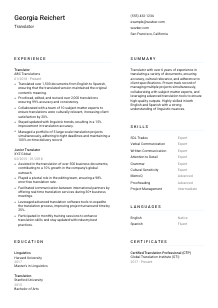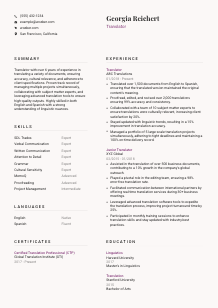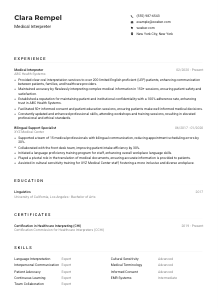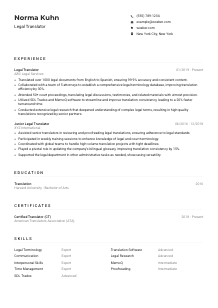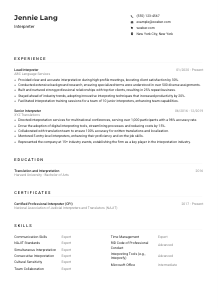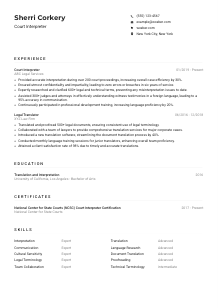Translator CV Example
Bridging languages, but your CV seems lost in translation? Dive into this Translator CV example, interpreted with Wozber free CV builder. Learn how to encapsulate your linguistic talents to align with job expectations, ensuring your career communicates as fluidly as your translations!
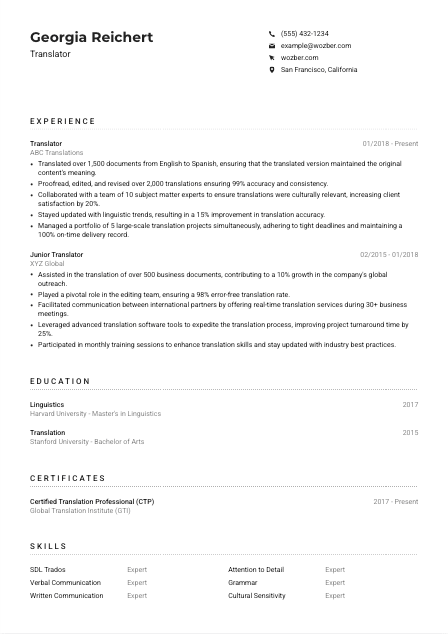
How to write a Translator CV?
Hey there, future Translation Maverick! In our multilingual world, your ability to bridge languages is more than a skill—it's a superpower. But even superheroes need to ace their CVs to land their dream roles. Fear not, for with the Wozber free CV builder, you're about to sculpt a CV that's not just a document but a ticket to your next adventure in translation.
Prepare to blend your linguistic finesse with the precision of tailoring your CV to your dream job. Let's transform your professional story into an irresistible narrative!
Personal Details
The Personal Details section is where you whisper 'Hello' to the hiring world. It may seem straightforward, but it's where first impressions start. For a Translator, making the right first impression means aligning every detail with the job you're eyeing. Let's dial in on how you can perfect this section, ensuring it resonates with your professional identity.
1. Spotlight Your Name
Consider your name the headline of your career story. Make sure it stands tall and proud, in a clear, professional font. First impressions matter, and your name sets the stage.
2. Title It Right
Directly below your name, echo the job title you're after—"Translator" in this case. It's a simple yet effective nod to the role you're pursuing, subtly aligning your CV from the get-go.
3. Essential Contact Info
- Phone Number: List a reliable contact number, checking twice to ensure accuracy. This is your direct line, make sure it rings true.
- Professional Email: Opt for a straightforward, professional email format. Your email is a small reflector of your professional persona, keep it polished.
4. Location, Location, Location
"Must be located in San Francisco, CA." To marry your CV with this requirement, proudly stating "San Francisco, California" in your contact details can be your golden ticket.
5. A Professional Snapshot
If you have a LinkedIn profile or a personal website showcasing your translation portfolio, include it. Make sure they're snapshots of your professionalism and echoing the narrative of your CV.
Takeaway
Think of the Personal Details section as the first handshake with your future employer—make it confident and aligned with the role. It's not just about the details; it's about setting a professional and personalized tone right from the start. This is your opening act; make it count.





Experience
Here, the spotlight shines on your journey and triumphs. As a Translator, you've navigated through language barriers and cultural nuances, turning them into bridges of understanding. Let's map out how to reflect such a rich journey in your CV, making every word count to display your prowess.
- Translated over 1,500 documents from English to Spanish, ensuring that the translated version maintained the original content's meaning.
- Proofread, edited, and revised over 2,000 translations ensuring 99% accuracy and consistency.
- Collaborated with a team of 10 subject matter experts to ensure translations were culturally relevant, increasing client satisfaction by 20%.
- Stayed updated with linguistic trends, resulting in a 15% improvement in translation accuracy.
- Managed a portfolio of 5 large‑scale translation projects simultaneously, adhering to tight deadlines and maintaining a 100% on‑time delivery record.
- Assisted in the translation of over 500 business documents, contributing to a 10% growth in the company's global outreach.
- Played a pivotal role in the editing team, ensuring a 98% error‑free translation rate.
- Facilitated communication between international partners by offering real‑time translation services during 30+ business meetings.
- Leveraged advanced translation software tools to expedite the translation process, improving project turnaround time by 25%.
- Participated in monthly training sessions to enhance translation skills and stay updated with industry best practices.
1. Dissecting Job Requirements
Start with a fine comb through the job description. For our Translator example, experiences with specific translation software, like SDL Trados or MemoQ, and proficiency in English were a must. Make sure to highlight these in your experience.
2. Chronological Clarity
Structuring your experience from the latest to the oldest not only shows your journey but also puts your most relevant and current achievements front and center. It tells a story of progression.
3. Asserting Achievements
Quantify your success wherever possible. Did you manage multiple projects, or perhaps you're proud of a particular project that improved client satisfaction? Numbers speak louder than words, and in your case, they narrate your effectiveness and dedication.
4. Relevance Reigns Supreme
Keep your content lean and mean. If it doesn't serve the purpose of aligning with the job description, consider leaving it out. Your role in enhancing translations for cultural relevance or your adeptness at handling tight deadlines are the stars here.
5. Tailoring Techniques
Your experience with translation tools and specific language pairs should echo loudly in this section. If you've worked with SDL Trados, don't just say 'translation tools'; name-drop to align with the job requirements.
Takeaway
Imagine each entry in your experience section as a chapter of your professional story where you're the protagonist conquering challenges with skill and finesse. Let each point affirm why you're not just suitable but exceptional for the role. Dive deep, be specific, and let your experience sing.
Education
While the world of translation thrives on experience and skill, your educational background lays the foundation. Here's where we not just list your degrees but strategically display them to highlight your preparedness and alignment with the Translator role.
1. Highlight the Essentials
Directly reflect the job specification in your CV. A "Bachelor's degree in Translation, Linguistics, or a related field" is not just a requirement; it's a testament to your specialized training and passion for languages.
2. Simplicity Speaks Volumes
Keep your education section clean and articulate. Name your degree, the institution, and the graduation year. This clarity respects the hiring manager's time and keeps their focus on your qualifications.
3. Degree Details Matter
If you majored in Translation or Linguistics, make sure it's front and center. It's not just about having a degree; it's about having the right one for the right job. Showcasing your specialization speaks volumes.
4. Relevant Extras
Courses, seminars, or workshops that sharpened your translation skills or expanded your linguistic knowledge could be worth mentioning, especially if they align closely with the role's requirements.
5. Display Distinctions
Graduated Summa Cum Laude? Part of the Linguistic Honor Society? These accolades not only show academic excellence but also a dedication to your field that goes beyond the classroom. Share these achievements, they make you shine.
Takeaway
In translation, where nuances and accuracy can change the impact of entire documents, your education is a beacon of your expertise. Illuminate this section with your achievements and relevant qualifications, ensuring it echoes the depth of your knowledge and your commitment to excellence in the field.
Certificates
While a Translator's world is one of words and languages, certificates can serve as concrete markers of your skill and commitment to continuous learning. Here, we hatch a plan to use your certifications not just as badges of honor, but as vibrant testimony to your dedication.
1. Align with Expectations
In the realm of translation, some roles might not explicitly require certifications, but showcasing relevant ones like Certified Translation Professional (CTP) could set you apart as a committed professional.
2. Quality, Not Quantity
Choose certifications that underscore your proficiency with translation tools (e.g., SDL Trados) or linguistic prowess. These specifics help weave a narrative of expertise and targeted skill development.
3. Date Details
Including the date acquired for time-sensitive certifications can highlight your current relevance and dedication to staying updated in a fast-evolving field.
4. Never Stop Learning
The translation field, with its ever-evolving technological tools and linguistic nuances, demands continuous education. Demonstrating ongoing learning through recent certifications can communicate your adaptability and enthusiasm for growth.
Takeaway
Think of certifications as your secret arsenal in proving your expertise. They're concrete proof of your commitment to excelling in your craft. Selected judiciously, they tell hiring managers that you're not just meeting the benchmarks; you're setting them.
Skills
In the finely woven tapestry of your CV, your Skills section shines as a beacon of proficiency. For a Translator, it's not just about listing abilities; it's about showcasing the right combination of linguistic, technical, and interpersonal skills that make you stand out.
1. Match Job Descriptors
Every skill listed should be a reflection or a counterpoint to a requirement in the job description. From proficiency in translation software like SDL Trados to an unwavering attention to detail, each skill should serve a clear purpose.
2. Highlight Your Arsenal
Prioritize the skills that the job emphasizes most. Your mastery of SDL Trados, keen eye for detail, or knack for managing multiple projects should not be buried in a list but highlighted as your main assets.
3. Organized and Focused
Resist the urge to overload this section. Instead, curate a focused list of skills that speak directly to the Translator's role, ensuring that you present as a tailored fit, not a generalist.
Takeaway
Keep your skills polished and your list precise. This section is your chance to showcase the unique toolkit you bring to the role. Focus on what makes you indispensable as a Translator—let your skills make the case for you.
Languages
For a Translator, language skills are the core of your craft. Here, we dig into how to present your linguistic abilities in a way that not only meets the job requirements but also showcases your proficiency and passion for languages.
1. Essential Language Identification
Start by identifying the languages required for the job. For instance, "Proficiency in English required" directs a spotlight on your English skills. List it first and denote your proficiency clearly.
2. Showcase Your Palette
Detail other languages you are proficient in, emphasizing your versatility and cultural adaptability. This can be a treasure in translation roles where additional languages might open new doors.
3. Honest Proficiency Levels
Label your languages accurately—from 'Native' to 'Basic'—painting a clear picture of your linguistic range. This honesty not only fosters trust but also helps align expectations.
4. Emphasize Cultural Connectivity
A Translator does more than convert words; they bridge cultures. Highlight languages relevant to the role's cultural context, signaling not just your linguistic ability but also your cultural sensitivity.
5. The Bigger Picture
Languages are your toolkit for global connection. Even if the job's primary focus isn't on international reach, showcasing your multilingual abilities hints at your potential for broader roles.
Takeaway
Your linguistic skills are the heart of your CV, opening pathways to understanding and connection. Display them with clarity and pride, embracing the multitude of worlds each language invites you to explore. You're not just a Translator; you're a cultural ambassador.
Summary
The Summary is your CV's opening scene, setting the stage for the narrative to follow. For Translators, it's the opportunity to encapsulate your linguistic prowess, cultural insight, and technical acumen in a few, compelling lines.
1. Paint the Big Picture
Kickstart with a sweeping statement that captures the essence of your professional identity. "Translator with over 6 years of experience in translating a variety of documents, ensuring accuracy, cultural relevance, and adherence to client specifications."
2. Highlight Standout Skills
Delve into specifics. Through sharp, concise bullets, weave in how your skills result in tangible outcomes like project management prowess, collaborative successes, or software expertise.
3. Speak to Your Successes
Select achievements that mirror the job's demands. Managed multiple projects? Improved translation accuracy? Let these successes paint a vivid picture of your capabilities.
4. Precision and Passion
Your summary isn't just a list; it's a narrative. Conclude with a line that reflects your dedication to the craft of translation, hinting at both your precision with language and your passion for bridging cultures.
Takeaway
Your summary sets the tone for the rest of your CV, teasing the depth of experience and skill you bring to the Translator role. Craft it with the respect it deserves, letting every word count. It's your first impression, your handshake, your smile—all rolled into one. Make it memorable.
Your Journey Begins Here
With the completion of this guide, you're equipped to craft a Translator CV that not only meets the mark but soars beyond expectations. Leveraging the Wozber free CV builder, including its free ATS-friendly CV templates and ATS CV scanner for keyword optimisation, you're ready to translate your professional journey into a compelling narrative. Use this guide as a beacon, and remember, every word on your CV is a reflection of your unique story and linguistic gift. Go forth, translate your dreams into reality, and let the world hear your voice in all its translated clarity!

- Bachelor's degree in Translation, Linguistics, or a related field.
- Minimum of 3 years of professional translation experience.
- Proficiency in at least two languages (source and target) with native-level fluency in the target language.
- Familiarity with translation software tools, such as SDL Trados or MemoQ.
- Excellent verbal and written communication skills, with strong attention to detail and grammar.
- Proficiency in English required.
- Must be located in San Francisco, CA.
- Translate written materials from one language to another, ensuring that the translated version maintains the meaning of the original content.
- Proofread, edit, and revise translations to ensure accuracy and consistency.
- Collaborate with subject matter experts and other team members to ensure quality and cultural relevance.
- Stay updated with evolving linguistic trends, terminologies, and client preferences.
- Manage multiple projects simultaneously, adhering to tight deadlines and maintaining high-quality standards.





